When your water heater pilot light is lit but burners won’t ignite, there can be many things wrong with your heater. A damaged gas control valve, thermopile malfunctioning, burner jet and lights are rusty, a closed automatic vent, clogged burner orifice could be the culprit behind the issue.
Plus, a corroded thermocouple, defective automatic gas shutoff, bad circuit board, sediment buildup, blocked gas line, dirty filter, thermostat malfunctioning, & worn-out heating system are also responsible for your heater not working.
Read our guide to ignite your heater as it should be ASAP.
Table Of Contents
- Pilot Light Lit But Burners Won’t Ignite [13 Easy Fixes]
- 1. Damaged Gas Control Valve
- 2. Thermopile Malfunctioning
- 3. Burner Jet And Lines Are Rusty
- 4. Closed Automatic Vent
- 5. Clogged Burner Orifice
- 6. Corroded Thermocouple
- 7. Defective Automatic Gas Shutoff
- 8. Bad Circuit Board
- 9. Sediment Buildup
- 10. Blocked Gas Line
- 11. Dirty Heater Filter
- 12. Thermostat Malfunctioning
- 13. Worn Out Heating System
- FAQs:
- Why is my furnace running but not igniting?
- What problem will cause if the thermocouple is not receiving the flame?
- Where is the flame sensor in my furnace?
- How often should a flame sensor be replaced?
- How often do furnace ignitors fail?
- Conclusion
Pilot Light Lit But Burners Won’t Ignite [13 Easy Fixes]
In this section, we have taken a more in-depth look at the reasons why your pilot’s light-lit burner won’t ignite. We also come up with the simplest solution for each of these causes.
Note: You can also read how to fix the Atwood water heater won’t ignite problem.
1. Damaged Gas Control Valve
An out-of-service gas control valve with defective mechanics may fail to release gas for the burners to light up. This can be why even when the pilot is lit, your burner won’t fire.
Solution:
Unfortunately, if the issue is with your gas control valve, there isn’t much you can do. Any suitable parts for servicing can be found on the market. As a result, you’ll have to replace the entire assembly.
2. Thermopile Malfunctioning
Your heater’s thermopile detects the pilot fire before letting the gas valve release gas to light up the burner. When the thermopile has gone bad, your burners won’t ignite due to the failure of flame detection.
Solution:
First, grab a multimeter to measure your thermopile’s output. The output of the thermopile must be at least 350mV. Remove the thermopile from the burner if the voltage is less than 350mV.
Then, remove the rust and corrosion build-up. Your heater should be working just fine now.
3. Burner Jet And Lines Are Rusty
Unless you examine the main burner, line, and jet, you don’t need to replace the entire assembly. If the primary burner’s line and jet become corroded by dust, debris, and grime, it will not light.
Solution:
Take out the burner from its housing to fix the problem. After that, look over the burner line and jet. Take an air compressor and blow out any loose dirt or debris on the burner line and jet.
Use WD-40 on the rusted lines and jet to degrease and lubricate them for rust removal. Hopefully, that solves your problem. Otherwise, you are looking at a replacement.
4. Closed Automatic Vent
Most gas heaters have vents, regardless of whether you own one. Your heater will not light if they remain closed.
In addition, most gas heaters feature two switches: one for flame roll-out and another for flue gas spill. The primary burner will not light if they become malfunctions.
Solution:
Make sure your burner’s automatic vents are open. If your heater won’t turn on because the vents are closed, it’ll be a simple remedy.
Also, make sure your gas heater’s switches are in good working order. Replace them with new ones if any of them become faulty.
5. Clogged Burner Orifice
A dirty burner orifice that is blocked with soot, grime, and dirt can be why your burners won’t ignite even with the pilot on. You need to make cleaning your burners part of the maintenance schedule of your heater.
Solution:
You need to clean your heater burner to make your heater work again. It will require a wire brush, sandpaper or emery cloth, a can of compressed air, and other tools to dismount the burner.
But before starting anything, you need to unplug your heater and switch off the gas supply. Also, watching the video will be helpful for you.
6. Corroded Thermocouple
If the thermocouple becomes rusted or buried in corrosion, the burner will not light. The temperature might be affected if the thermocouple becomes rusted. As a result, your burner will not function properly.
Solution:
Cleaning the thermocouple with a vacuum is an easy way to eliminate rust and corrosion. To remove dirt and debris from the thermocouple, use a vacuum with a brush attachment.
Keep in mind that the area around the burner will be quite hot. Make sure the thermocouple is completely cool before vacuuming it.
There is a risk of fire if this is not done. Reinstall the thermocouple after cleaning it. If cleaning the thermocouple doesn’t help, get a new one and replace it.
7. Defective Automatic Gas Shutoff
Occasionally, the pilot will stay lit but the burner will not light. The reason for this is the pilot shut-off does not turn off when the burner’s safety switch does. A failed automated shut-off is another name for it.
Solution:
To begin, hard strike the control valve with a screwdriver. It will assist in dislodging the little disk, and the pilot light will turn off. Turn the control knob to the OFF setting if you can’t get the little disk out.
Then, to turn off the pilot light, turn the dial on your control knob off. Remove the thermocouple from the unit after removing the pilot. To fix the problem, purchase a new one and install the thermocouple.
8. Bad Circuit Board
The circuit board can cause a whole host of problems if it malfunctions. The pilot stays lit but burners won’t ignite is just one of those problem.
Solution:
You need to replace the control board. Contact your heater manufacturers for a new control board. After acquiring one, have a professional help you replace it.
9. Sediment Buildup
A buildup of sediment at the bottom of a tank might easily cause your thermostat to fail. Because the sediment acts as insulation, your thermostat will reach the desired warmth before your water does.
So, your burners don’t light up as the thermostat doesn’t call for heat.
Solution:
Warm water failing to heat up as needed is frequently caused by this buildup. Popping or pounding noises, as well as mucky or foul-smelling water, are all signs of sediment collection.
If you see any of these symptoms, it’s time to contact a professional.
10. Blocked Gas Line
If there is a complete blockage in the gas line, the gas heater will not stay lit. A minor obstruction may allow the burners to ignite but not maintain their flame for long.
Solution:
A length of narrow but strong wire can be used to clean the gas lines that travel from the gas cylinder to the grill.
To clean the gas lines properly, you should try to find a piece of wire that is bigger than the connectors. You’ll be able to push the wire through instead of pulling it back.
11. Dirty Heater Filter
Dirty heater filters obstruct proper airflow and cause the heater to overheat. This triggers the high-limit switch and shuts off the heater.
Solution:
Remove the heater filter. If it is reusable, clean it up with a garden hose. Use a brush to wash out all the dirt and dust. For a one-time use filter, you need to replace it with a new one.
12. Thermostat Malfunctioning
A thermostat, like any other electrical item, can break down, and this might cause problems with the burner. Thermostats lose accuracy over time and might potentially degrade the effectiveness of your heater.
If the thermostat can’t connect with the heater effectively, the pilot light may operate but the burner will not.
Solution:
This is a simple remedy that only requires you to change your thermostat. Adjust the temperature while your thermostat is set to “away” or “vacation.” Check to check sure the burner and pilot light are working properly.
Your water heater’s burner shouldn’t be on all of the time, but it should switch on when you need it. If you discover that your thermostat is affecting the functioning of the burner, you may need to replace it.
13. Worn Out Heating System
Your heater has to be at least 10-12 years old for this to be your issue. Heaters that are too old can break down in a variety of ways, including the burner.
Leaks, rust, and banging noises are all indicators that your water heater is too old to perform correctly.
Solution:
In this case, it is more practical to replace the heater instead of spending on costly repairs constantly.
FAQs:
Why is my furnace running but not igniting?
It’s most likely due to a faulty, broken, or dirty ignitor/sensor if your gas furnace starts but doesn’t fire up. You can wipe the sensor and change the ignitor if this is a common furnace problem.
What problem will cause if the thermocouple is not receiving the flame?
Your heater’s gas valve won’t open. As a result, without gas, there will be no ignition at the burner. No heat will be produced.
Where is the flame sensor in my furnace?
The flame sensor is situated on the burner assembly. A thin metallic rod, it’s usually bent and sits immediately in front of the furnace’s pilot flame.
How often should a flame sensor be replaced?
Over the duration of the furnace’s life, you’ll have to change the flame sensor once, twice, or three times. It’s perfectly common to have a defective flame sensor; all you need to know is how to recognize when it’s gone bad so you can replace it before it’s too late.
How often do furnace ignitors fail?
Furnace ignitors survive roughly four to seven years on average. This is dependent on how well the system is maintained. It’s time to replace it after seven years.
Conclusion
Hopefully, now you have an answer to your question “why won’t my burners ignite?”. If you face any other trouble regarding your heating appliance, leave us a comment below.

